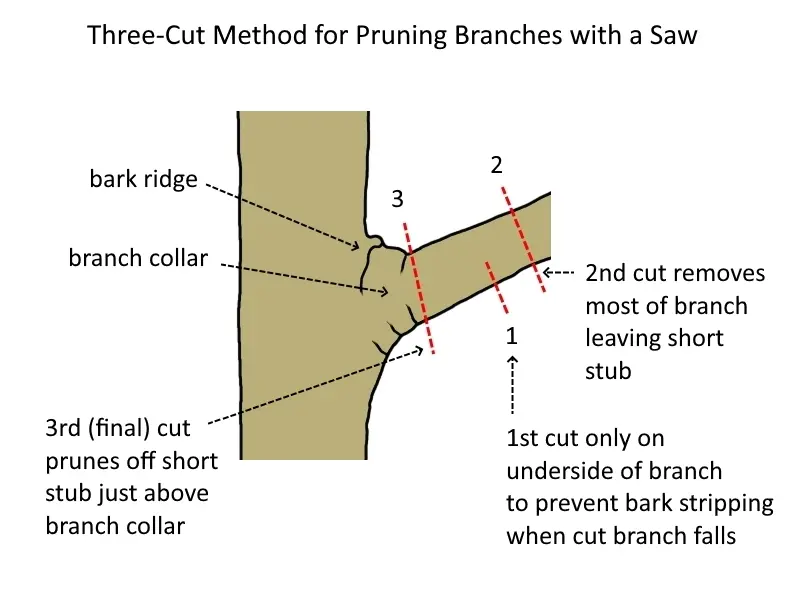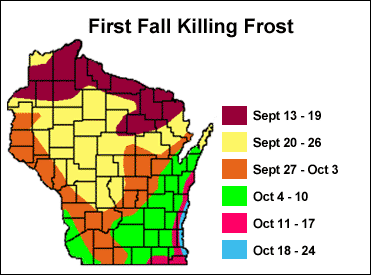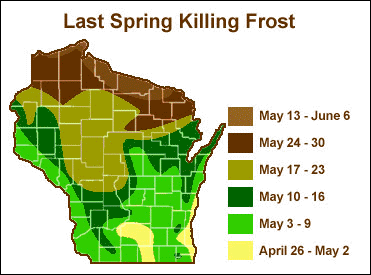A common question I get asked is, "when is a good time to prune my tree(s)"? Although the answer is not the same for all trees, I generally recommend pruning deciduous trees (trees that lose their leaves in fall) in the dormant season. Trees in northeastern Wisconsin are usually fully dormant around November and start to come out of dormancy sometime in April/May. Pruning when trees are dormant allows for a better view of the tree and its branches, infection from diseases is reduced as pests are inactive (this is especially important when pruning oak and elm trees) and pruning wounds tend to seal quicker when the tree is dormant.
Frost dates are a good reference to when trees are dormant.
What to prune:
Remember the 3 D's. Remove any dead, diseased or damaged limbs. Dead, diseased or damaged branches are more likely to fall from the tree. This is a concern if the branch is large and/or up high. Removing the 3 D's reduces risk. It also helps to promote a healthier tree and improve its overall appearance.
* If pruning diseased trees, make sure to disinfect your pruning tool between cuts with 70% rubbing alcohol or a 10% bleach solution. This will help prevent the spread of diseases. If pruning a group of trees, prune the diseased tree last.
Look for any crossing or rubbing branches and remove the weaker/ less desirable branch. Branches that rub together create wounds. The continual rubbing makes it difficult for wounds to seal which creates an entry point for infection.

Remove suckers coming from the base of the trunk or roots. This is more common on certain species such as crab apple trees.
The key to a structurally sound tree is having one dominant leader. Trees with codominant leaders (two or more main leaders that are equal in size) have a greater likelihood of failure as these limbs are weakly attached. This comes from a defect known as included bark. Restoring a central leader is best done in young to medium aged trees.
In order to do this:
Identify the best stem that you want to become the dominant leader.
Determine which stems are in competition with the dominant leader.
Subordinate or remove the competing stems.
* Most of the time this type of pruning cannot be accomplished in one pruning session. Instead it is done over multiple years. It is important to know that not all trees are candidates for this type of pruning because of advanced age and preexisting defects.

Proper pruning cuts:
When pruning it is important to identify some parts of the tree before making the cut. First locate the branch collar. This is a swollen area of tissue that forms around the base of the branch. Next find the branch bark ridge. This is a line of rough bark that runs from the crotch of a branch (where the top of the branch meets the trunk) to the trunk. The branch bark ridge is not always visible in trees.

Cut from the branch bark ridge to just outside the branch collar. It is very important to avoid cutting into the branch collar as this area holds antifungal chemicals that are used in sealing off decay. Cutting into the branch collar creates a larger wound and increases the likelihood that decay spreads into the trunk.
When pruning larger branches use the three cut technique shown below to keep the branch from tearing. Tearing removes important branch collar tissue and creates a larger wound than desired.

Try to prune branches 3" in diameter or less. Smaller wounds seal over quicker and reduce the chance of internal decay. Avoid making cuts larger than 4" in diameter when possible. Decay will eventually set into wounds of this size.
Other guidelines:
Don't remove more than 25% of living crown tissue in trees. For older trees this number is much less.
Most pruning practices should maintain the trees natural shape.
Avoid pruning newly planted trees. After planting, trees spend a lot of their energy into root development. Pruning during this time can further weaken already stressed trees and unintentionally stimulate above ground growth.
Avoid topping trees. Topping creates large wounds that do not seal over properly. These drastic cuts allow decay to get into trees which will lead to structural defects and potential failure in the future.
Don't dress/cover pruning wounds with paint or any other material. Most dressings will eventually degrade and allow moisture in. This will ultimately create a more favorable environment for decay.
* The exception to this is pruning oaks and elms between April and September in northeastern Wisconsin. Oak trees, especially red oaks, can get oak wilt and native American elm trees can get Dutch elm disease. These fatal diseases are spread by beetles that feed on sap. Research has shown that these beetles can find fresh wounds (sap) ten minutes after it was created. Its best to avoid pruning oaks during this time to minimize potential disease transmission. If you must prune oaks or elms during the growing season, paint wounds immediately after pruning. That means have the wound dressing on hand. Don't make the cut then go to the store to buy dressing as it may be too late.

Always have an objective before pruning. If you don't there's a good chance you will prune too much, which you may regret.
Stay at least 10 feet away from power lines when working and don't work on trees that are touching powerlines. A common misconception is that power lines are insulated with a protective coating to prevent shocks. The coating on power lines is actually for weather proofing and does not offer any protection from the electrical current. If power lines are near or touching your tree, call your utility provider and/or a certified arborist to advise the situation. Be safe!
If you need help with your project you can find a certified arborist at: https://www.treesaregood.org/findanarborist



Comments